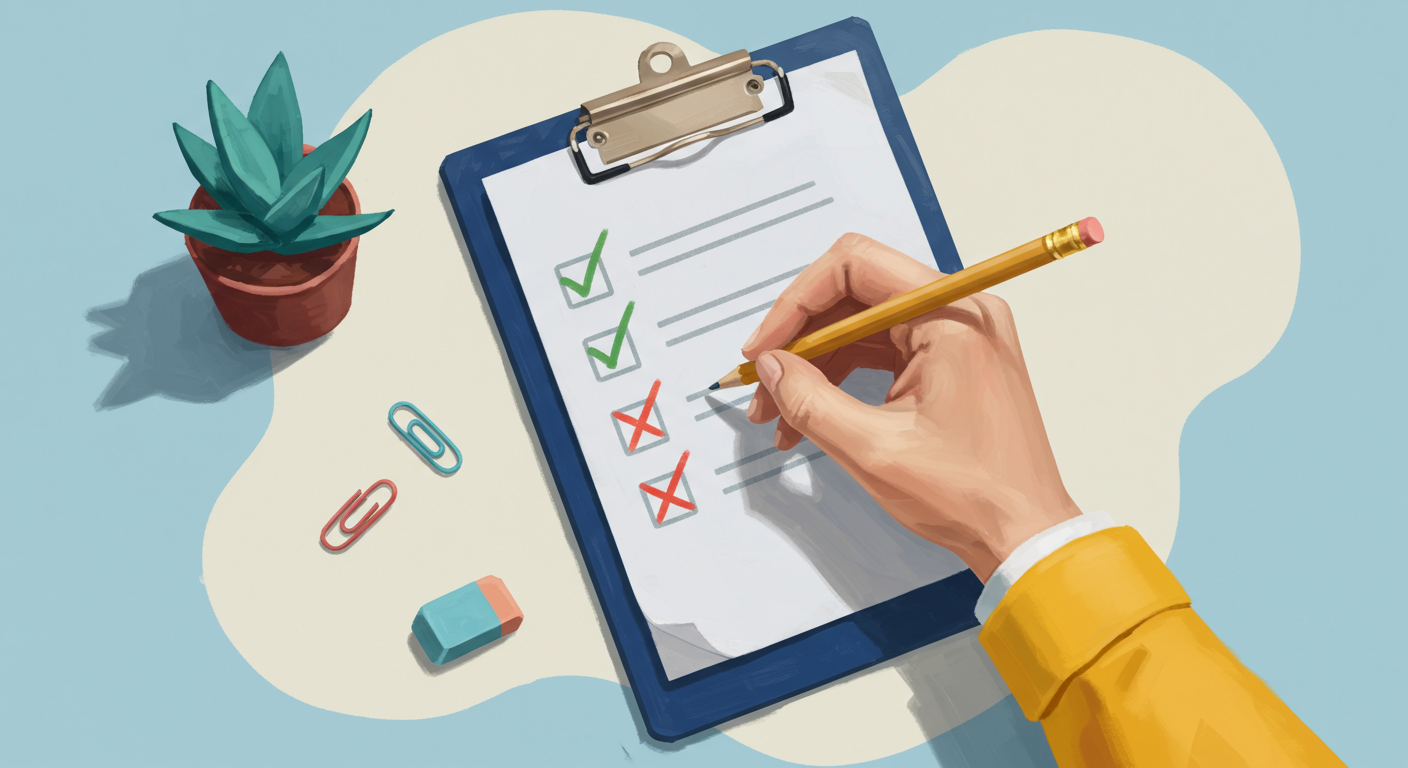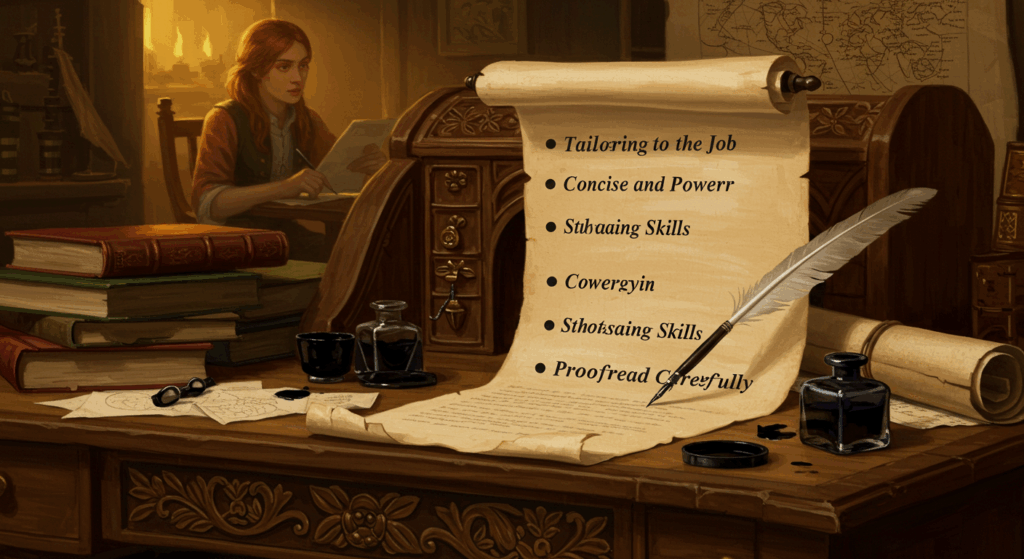Let’s be real: cover letters have major “ugh, do we have to?” energy. Between binging Netflix and pretending your laundry will fold itself, writing 300–400 words about yourself doesn’t scream “fun night in.” And yet… a good cover letter still moves the needle. It’s like the voiceover to your resume’s movie trailer: short, punchy, and designed to make the hiring manager say, “Okayyy, I need more.”
If you’ve ever thought, “What even is a cover letter and why does it still exist?” — same. This guide breaks it down in a practical way. We’ll talk purpose, structure, voice, and strategy. We’ll walk through examples, types, variations, and how to avoid the awkward, try-hard vibe that makes recruiters nope out. No stiff corporate robot enetgy. Just a chill, useful walk-through with some “ngl, that was helpful” moments.
Grab your iced coffee or… whatever beverage screams “productive me.” Let’s make this easy.
What a Cover Letter Actually Does (and Doesn’t)
Think of your resume as the playlist; the cover letter is the introduction track where you explain the vibe. The resume says what you did. The cover letter tells why those things matter to this job, right now.
It does:
- Translate your experience into the company’s language.
- Connect dots: career changes, gaps, weird zigzags (we all have ‘em).
- Show you can write clearly and professionally (yes, they notice).
- Hint at your personality without oversharing.
It doesn’t:
- Repeat your resume bullet-for-bullet.
- Tell your entire life story (save that for your podcast someday).
- Beg. We’re not doing needy energy; we’re doing value energy.
If your resume is an answer key, your cover letter is the short explsnation next to each answer that makes the grader nod.
When You Actually Need One
- When the posting asks for it. (Wild concept, I know.)
- When you have a non-obvious fit. Career pivot? New industry? Remote-curious? Explain the leap.
- When you have a referral. Put that up top, respectfully. It changes the read.
- When your impact is hard to see on a resume. Maybe your projects weren’t glamorous but the outcomes were A+.
Skip it only if the company explicitly says “no letters” or if the application flow literallly can’t accept it. Otherwise, short is better than none.
The 5-Part Skeleton (That Always Works)
Most strong letters follow a simple arc. Use this as your default, then tweak for different types and variations.
- Hook (1–2 sentences). Grab attention. Mention a connection (referral, product you use, recent launch you loved) or a high-impact win tied to their goals.
- Bridge (1 sentence). Name the role and summarize your fit in one clean line.
- Proof (1 short paragraph). 2–3 tight wins with outcomes. Avoid generic verbs and random adjectives. Numbers > fluff.
- Fit (1 short paragraph). Why this team, now? Show you’ve peeked at their roadmap, customers, or tech stack.
- Close (2–3 lines). Confident, light CTA: offer a call, attach portfolio, availability. No essays.
That’s it. You can write the whole thing in ~200–350 words. Not a novella. Not an apology letter. A value note.
Voice Check: Sound Like a Human (Who Works There)
Hiring managers want to predict how you’ll write in Slack and how you’ll talk to stakeholders. Pick a voice that matches the brand:
- Fintech or enterprise? Cleaner, more structured sentences. Crisp data points.
- Consumer app or creative? Warm, a bit playful, still professional.
- Academic or policy? Formal, precise, well-cited (but keep the letter itself tight).
Little tweaks go far: mirroring the company’s tone from their site or blog is a weirdly effective cheat code. You don’t have to cosplay, just meet them where they are.
How to Tailor in 14 Minutes (The Mini-Process)
Ngl, most people don’t tailor because it sounds like a two-hour chore. Here’s the fast version.
- Scan the job post: highlight 6–8 nouns/phrases (e.g., “lifecycle email,” “B2B pipeline,” “React + TypeScript,” “SOC 2,” “community partnerships,” “OKRs”).
- Open your resume: pick 2–3 bullets that tie to those nouns directly.
- Google the company for 5 minutes: new product launch, market news, customer stories, a blog post by the hiring manager. One tiny insight = instant “you did your homework.”
- Draft the hook: “I’m excited by X because Y result I drove at Z.” That one line frames the letter.
- Proof paragraph: paste 2 bullets, edit into short narrative. Include outcomes (metrics, efficiencies, growth).
- Fit paragraph: mention that mini-insight. Connect to their goals.
- Close: polite, confident, no groveling.
Done. You now look intentional, not spray-and-pray.
Format & Logistics (Because ATS Is Still A Thing)
Length: 200–400 words. One page max. White space is your friend.
- File: PDF unless they request something else.
- Font: Clean and readable (Inter, Calibri, Helvetica, Georgia). 11–12 pt.
- Header: Match your resume. Name, phone, email, portfolio/LinkedIn.
- Subject line (if emailing): “Application: [Role] — [Your Name].”
- Salutation: “Hi [Name],” if you have it. “Hi Hiring Team,” if you don’t. Avoid “To Whom It May Concern” unless you’re writing from the year 2003.
Common Mistakes (And Quick Fixes)
- Repeating your resume → Instead, interpret your resume. Add context, outcomes, and why it matters here.
- Buzzword soup → Translate jargon into impact. “Led cross-functional synergies” means nothing; “Shipped X that cut onboarding time 27%” means everything.
- Apologizing → Don’t lead with what you lack. Lead with a comparable win or fast-learning proof.
- One-size-fits-all → Tiny tailoring goes far. Swap 3 phrases, reference one initiative, done.
- Over-humble or over-hype → Aim for calm, earned confidnce. “Here’s what I’ve shipped; here’s why it aligns.”
Cover Letter Examples, Types, Variations (So You Can See It)
A big unlock is seeing patterns. Below are practical examples you can customize. I’ll call out the types and variations and why each works, so you can pick your lane.
Example #1 — The Classic, Concise (General Application)
When to use: You’re a solid match and want a clean, standard letter.
Why it works: Tight hook, 2–3 proof points, tailored fit, confident close.
Sample
Hi [Hiring Manager Name],
I’m excited about the [Job Title] role at [Company]—especially your push into [specific product/initiative]. In my last role at [Previous Company], I owned [responsibility] that led to [outcome], and I’d love to bring that momentum to your team.
Recently, I [impact #1] resulting in [metric or concrete change]. Before that, I [impact #2], which helped [team/org] [measurable improvement]. I enjoy translating messy problems into clear plans, partnering with [cross-functional partners], and delivering on time without drama.
I’m drawn to [Company] for [1 authentic reason], and I see room to support [their near-term goal] quickly. I’ve attached my resume and work samples. If it’s helpful, I can share details on [relevant project or repo].
Thanks for your time—looking forward to chatting.
—[Your Name]
Notes: Classic type. You can make variations by swapping the industry detail and the 2–3 proof points.
Example #2 — The “T-Format” (Impact Left, Relevance Right)
When to use: Analytical or sales roles; when you have crisp wins you can pair with requirements.
Why it works: It literally maps your experience to their needs. Managers love this.
Sample (abbrev)
Hi [Name],
1. Your Need: Build a qualified pipeline for mid-market
My Evidence: Sourced 118 mid-market opps in Q2, 31% above target, 18% conversion to SQL
2. Your Need: Shorten onboarding for new reps
My Evidence: Built a playbook that cut ramp time from 10 to 6 weeks
3. Your Need: Strong collaboration with marketing
My Evidence: Co-led a webinar series → 1,940 sign-ups, $410k influenced
I’m excited about [Company] because [reason]. Would love to share how I can replicate these outcomes for your team.
—[Your Name]
This type is a great variation when the posting lists clear outcomes. It’s an example that’s scannable for busy readers.
Example #3 — Career Switch (Pivot, but Make It Make Sense)
When to use: You’re changing fields (e.g., teacher → UX, ops → product). The cover letter becomes your translator.
Why it works: It reframes “lack of X years” into “relevant capabilities” and shows you’ve already started the new path.
Sample
Hi [Name],
As a former [Previous Field] professional stepping into [New Field], I’ve been applying my [transferable skill #1/2] to real projects. In the past six months, I [concrete action: certification, capstone, freelance], and shipped [result]. That learning curve has been energizing—and relevant to your [team/product].
At [Previous Company], I led [project] across [stakeholders] and delivered [outcome]. Those same skills—prioritization, user interviews, prototyping decisions—show up in my recent [bootcamp/freelance] work: [short result + link if allowed]. I’m excited about [Company] because [specific reason], and I’m confident I can drive [team’s near-term goal].
Thanks for considering—happy to walk through the projects and tradeoffs behind them.
—[Your Name]
A classic variation that centers the why behind your pivot. Use it as an exsmple to frame transferable wins.
Example #4 — Referral-First (Use the Intro You Earned)
When to use: Someone credible inside the org passed your name along.
Why it works: It adds trust immediately. Keep it humble and specific.
Sample
Hi [Name],
[Referrer Name], [their role], suggested I reach out about the [Job Title] role. We worked together on [brief project], and they thought my background in [skill] could help with [team’s challenge].
At [Current/Prev], I [impact #1] and [impact #2]. What excites me about [Company] is [specific initiative or customer problem]. If helpful, [Referrer] can share context on my work; I’d also be glad to walk you through [portfolio or metrics].
Thanks for your time,
—[Your Name]
A type that benefits from the human link. This variation is short on purpose—let the referral do the opening lift.
Example #5 — Early Career / Entry-Level (No Experience? Show Initiative.)
When to use: Internships, first roles, part-time → full-time.
Why it works: It leans on proof of initiative, not job titles.
Sample
Hi [Name],
I’m applying for [Job Title] at [Company]. In school, I led [project/club] where we [result], and outside class I built [tiny project] that [metric]. I’m especially proud of [impact] because it taught me [skill relevant to the posting].
Your team’s work on [specific initiative] caught my eye. I’ve been learning [tool/stack], and completed [course/cert/project]. I’d love to support [goal] while continuing to level up fast.
Thanks for your consideration—happy to send links or code.
—[Your Name]
A great example of matching energy with learning velocity. This type shows you’re coachable and already moving.
How to Write About Results (Even If You Don’t Track Numbers)
Numbers make people perk up. If you don’t have exact metrics, estimate responsibly or use qualitative outcomes:
- Time: “Cut onboarding from ~8 to ~5 weeks.”
- Scale: “Supported 12 enterprise accounts across healthcare.”
- Quality: “Raised CSAT from ~3.8 to ~4.5 over two quarters.”
- Efficiency: “Automated weekly report; saved team ~6 hours/week.”
- Revenue/Cost proxy: “Improved trial-to-paid by ~5–7%.”
Not perfect? That’s okay. Anchored estimates beat vague adjectives every time.
Advanced Tailoring Moves (Tiny Things, Big Gain)
- Mirror a keyword or two from the posting in your proof paragraph. ATS will pick it up, humans will too.
- Show you understand the customer: “I’m a paying user of [product]; here are two friction points I’d love to help fix: [X, Y].”
- Name the collaborators: “Partnered with PMM, Legal, and Eng to ship [project].”
- Future-leaning sentence: “In the first 60 days, I’d focus on [quick wins that are actually achievable].”
- Add 1 neat detail: A talk the hiring manager gave, a line from the company’s values, a recent launch.
These aren’t gimmicks. They’re proof you’ll care in the job the way you cared in the application.
The Fine Line Between Personality and TMI
You can be warm and modern without oversharing your entire ~situationship~ with employment. Keep jokes light and infrequent. Emojis are risky unless the brand is very casual. Choose 1–2 moments of voice (a gentle aside, a tiny joke) and prioritize clarity over cleverness. If the sentence looks like it would age badly in an investor memo… rewrite it.
Handling Tricky Situations (Because Life)
- Employment gap: One sentence. “After a family leave (Jan–Aug), I completed [course/project] and I’m ready to contribute.” Then move on.
- Short stints: Emphasize project outcomes, not dates. “In five months, shipped X and stabilized Y.”
- Layoff: You don’t have to say why in the letter. If you do, keep it neutral. “Role was eliminated in org restructuring.”
- Salary questions: If the posting asks, give a range in the application form, not the letter. Keep the letter focused on value.
- Location: If you’re remote-ready or open to relocation, one line at the end is fine.
“But Can I Use AI to Draft It?”
Yes, with judgment. AI is a great brainstorming buddy and editor, but make the letter yours:
- Generate a rough draft (or use the templates above).
- Replace generic phrases with your specifics.
- Read it out loud and cut anything that sounds like it belongs on a motivational poster.
- Keep the examples, types, variations you used honest. Don’t invent metrics you can’t defend.
Quick Checklist Before You Hit Send
- Name spelled right? Role correct? (You’d be shocked.)
- 1–2 tailored sentences that only fit this company?
- Two proof points with outcomes?
- File name tidy:
Firstname-Lastname-Cover-Letter-Company.pdf - Tone consistent with the brand?
- Clean close with availability/contact?
If all boxes are ticked, ship it. Then reward yourself with a snack because you earned it.
More Examples with Micro-Breakdowns
Sometimes seeing micro-moves helps. Here are line-level variations to steal shamelessly and adapt.
Opening hooks (choose one)
- “I’m applying for [Role] to help [Company] turn [recent initiative] into [measurable outcome].”
- “As a [job title] who’s shipped [X], I’m excited about [Company]’s [product], especially [feature].”
- “After improving [metric] at [Prev Company], I want to bring that same focus to [Company]’s [team].”
Proof intros (mix 1–2)
- “In my last role, I…”
- “Earlier this year, I…”
- “Across [timeframe], I led…”
Outcome closers
- “…which reduced [cost/time] by [X%].”
- “…which unblocked [stakeholders] and sped up [process].”
- “…resulting in [growth metric] across [segment].”
Fit sentences
- “Your focus on [customer/market] lines up with my experience in [adjacent domain].”
- “I’m especially drawn to [value or principle], which shows up in how I [work example].”
Closes
- “I’d love to share more about [project].”
- “Happy to send code, dashboards, or a quick Loom if useful.”
- “Thanks for your time—I’m excited to chat.”
Keep these as modular types of lines that you can plug into different variations of letters. Real talk: 80% of cover-letter writing is rearranging clean building blocks.
Frequently Asked (Actually Useful) Questions
How long should it be?
Short enough to read on a phone without scrolling forever. 200–400 words is the sweet spot.
Do I address it to a person?
If you can. A 2-minute LinkedIn search might reveal the hiring manager. If not, “Hi Hiring Team,” is totally fine.
Do I need one if the application says “optional”?
Yes, if it’s reasonable to write. “Optional” means “Most will skip this; stand out if you don’t.”
What file format?
PDF. Keep formatting stable; don’t play roulette with .docx.
Can I reuse the same letter?
Use a base and tailor 3–5 phrases. It’s the tiny tailoring that matters.
What about design-y templates?
Cool if you’re a designer. Otherwise, simple layout > fancy borders.
A Word on Types and Variations by Role
- Product / PM: Prioritize outcomes, decisions you made with tradeoffs, cross-functional collaboration. A T-format variation is clutch.
- Engineering: Mention stack fluency, shipped features, performance wins; link to repos if allowed. Keep tone pragmatic.
- Marketing: Story + data. Campaigns, CAC/LTV, pipeline influence, retention lifts. A narrative type with 2 bullets works.
- Sales / CS: Quantify pipeline, quota %, retention, expansions. Referral example shines here.
- Design / Content: Link to portfolio. Talk process and impact, not just aesthetics.
- Ops / HR / Finance: Process improvements, error reductions, time saved, compliance achieved.
- Early career: Initiative, projects, inteenships, competitions, community work. Treat them like mini-case studies.
Across all types, pick one variation that aligns with how that function proves value, then plug in your best examples.
A Reusable Template (Fill-In-the-Blanks)
Copy-paste into a doc and customize. Promise me you’ll tweak at least three phrases.
Header
[Your Name] | [Email] | [Phone] | [LinkedIn/Portfolio]
Salutation
Hi [Hiring Manager Name or Hiring Team],
Hook + Bridge
I’m excited to apply for [Role] at [Company] because [specific reason]. In my recent work at [Prev Company], I [high-impact thing], which led to [outcome]. I’d love to bring that momentum to your team.
Proof
Across [timeframe], I [win #1: action → outcome]. Earlier, I [win #2: action → outcome]. I enjoy [relevant way of working], and I collaborate closely with [partners] to deliver results without the chaos.
Fit
[Company]’s focus on [customer/market/initiative] resonates with me. I see opportunities to support [near-term goal] by [brief plan or angle that aligns with posting].
Close
I’ve attached my resume and [portfolio/links]. Thanks for your time—looking forward to chatting.
—[Your Name]
Keep it to one page with breathable spacing. Swap in the types and variations you saw earlier based on the role.
Tiny Editing Pass (The 5-Minute Polish)
- Remove one adverb. Then another. (They creep in.)
- Replace a vague verb with a concrete one.
- Read aloud once. Fix any sentence where you ran out of breath.
- Kill filler openers like “I am writing to express…” (We know.)
- Check that each paragraph earns its existence. If not, merge or delete.
Your future self will thank you.
Final Thoughts: Your Letter Is a Door-Opener, Not a Thesis
A cover letter isn’t a biography. It’s a nudge. The goal is to spark a conversation where you can tell the fuller story. Keep it human, keep it true, and keep it useful to them. Use the examples above, pick the types and variations that fit your situation, and ship it with calm confidence.
You got this. Seriously. Now open a fresh doc, set a 20-minute timer, and draft yours. Then apply to that role you’ve been side-eyeing for weeks. Hit send. Future-you will be like, “Dang, we actually did that.”









